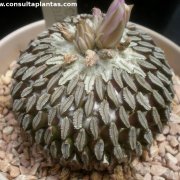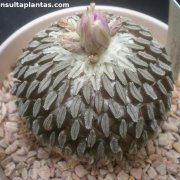Care of the cactus Pelecyphora aselliformis or Hatchet Cactus |
|
The genus Pelecyphora, family Cactaceae, includes 2 species of cactus native to Mexico: Pelecyphora aselliformis and Pelecyphora strobiliformis. Common names: Woodlouse Cactus, Hatchet Cactus. Scientific synonyms: Anhalonium aselliforme, Ariocarpus aselliformis, Mammillaria aselliformis. This species is native to San Luis Potosí, Mexico. They are small cacti with a very slow growth and globular body in its youth (later cylindrical) that reach 10 cm (3.93") in height. The epidermis is greyish green in color and they have very small tubercles with cylindrical-linear areoles with tiny spines (up to 60) that do not puncture. They produce flowers of 3 cm (1.18") in diameter and purplish red in color on the upper part of the cactus. Hatchet Cactus is used in pots and planters, in greenhouses and in mini gardens for cacti and succulents. Pelecyphora aselliformis needs full sun exposure and a hot, dry climate. In winter it is better that the temperature is not lower than 5 ºC (41 ºF). The soil can be a mixture of leaf mulch and coarse siliceous sand in the same proportions or a commercial substrate for cacti. Woodlouse Cactus is not transplanted often because it grows very slowly. Water moderately in spring and summer, waiting for the substrate to be well dry. In mid-autumn stop watering until early spring. Fertilize once with mineral cactus fertilizer in spring. Hatchet Cactus does not need pruning. The biggest danger for Pelecyphora aselliformis is excessive humidity. Propagation is not easy because it takes many years to emit suckers and through seeds it's a very slow process. |
Images of the cactus Pelecyphora aselliformis or Hatchet Cactus |
Find plants
Pelecyphora aselliformis or Hatchet Cactus | Care and Growing
© 2026 FavThemes



